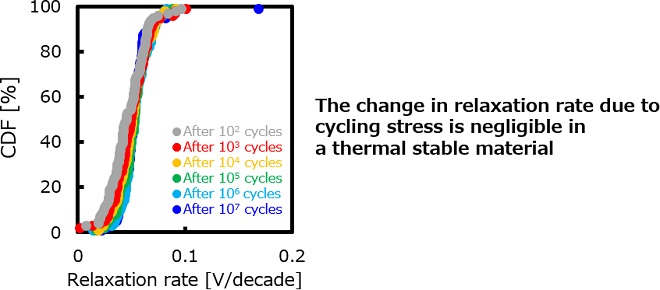Please select your location and preferred language where available.
Understanding the Cycling-Dependent Threshold Voltage Instability in Selector Devices
February 15, 2023
Recently, two-terminal selector devices based on chalcogenide materials have attracted much attention towards next-generation high-density memory cell arrays. In this work, the reliability of the selector devices has been studied in collaboration with imec, the world-leading R&D center in electronics technologies. The ON/OFF switching mechanism of the devices is considered as follows: the formation/break-up of a conducting path induced by applying/removing an electric field (Fig.1).

In the devices used in this work, it is founded that the threshold voltage (Vth) relaxation, that is, Vth drift towards larger values with increasing the wait time during OFF state (relaxation time, trelax), becomes faster after ON/OFF switching cycling (Fig.2). In other words, the relaxation rate becomes larger after cycling. Even if the same relaxation time passes, Vth values vary depending on the cycling stress applied to the devices. This Vth instability should have a significant impact on the reliability of array operations.

- Relaxation rate: The change in Vth values per an order of magnitude of relaxation time
To address this issue, the mechanism behind the accelerated relaxation has been deeply investigated. The detailed electrical characterization and modeling revealed that Joule heating generated during cycling causes this phenomenon. The cycling-induced accelerated relaxation is suppressed in a material which has high thermal stability (Fig.3). This result further confirms that the accelerated relaxation is caused by thermal energy.
These results contribute to reliable array operations.

This achievement was presented at 2022 IEEE IEDM (International Electron Devices Meeting) [1].
This material is a partial excerpt and reconstruction of the reference [1] @ 2022 IEEE.
Reference
[1] M. Yamaguchi et al., IEDM2022, pp.94-97

